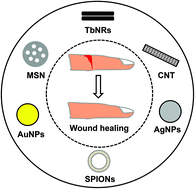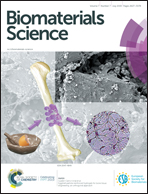Recent advances in inorganic nanomaterials for wound-healing applications
Abstract
Chronic wounds have emerged as a major cause of mortality, especially in patients with diabetes and other pathologies. Statistics indicate that chronic wounds affect around 6.5 million patients annually, with wound care and management incurring huge economic costs. Growing incidence of chronic wounds and associated pathologies along with the limitations of current therapies have established a strong need for novel and innovative approaches to accelerate wound healing. Conventionally, chronic wounds are addressed using various FDA-approved silver-based formulations and other biomaterials. However, the toxicity associated with these conventional approaches, along with the increased frequency of chronic wound cases, makes the development of alternative therapies for effective wound healing necessary. Recently, researchers have investigated the design and development of nanoparticles, especially inorganic metal nanoparticles, as promising candidates for addressing various pathological conditions, including wound healing. Several research groups, including ours, have designed numerous metal nanoparticles (including silver, gold, zinc oxide, cerium oxide, terbium hydroxide, silica, titanium oxide, copper) and demonstrated their wound-healing properties using in vitro and in vivo models. The rise of nanotechnology-based platforms in wound healing is evidenced by the tremendous impact and number of publications observed in recent years, which has emphasized the robust potential of inorganic nanomedicine for addressing wounds. Therefore, the importance of these inorganic nanomaterial-based interventions for wound-healing applications needs to be emphasized to inform and encourage scientists and young researchers globally to engage with this expanding area of biology and medicine. In this review article, we mainly focus on highlighting the role of inorganic nanomaterials and nanomaterial-based approaches for wound healing and tissue regeneration, along with their mechanistic properties, clinical status, challenges, and future directions.



 Please wait while we load your content...
Please wait while we load your content...